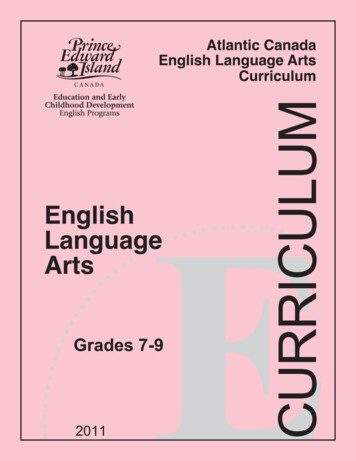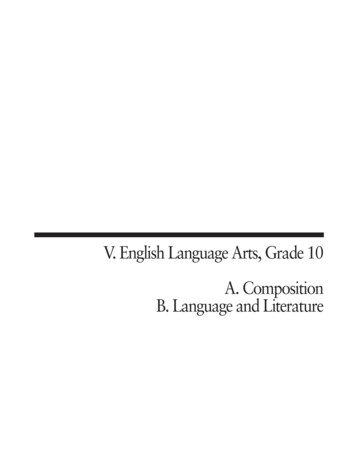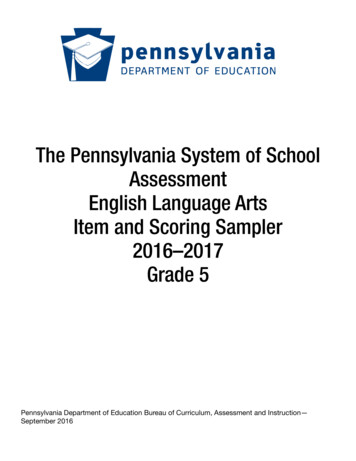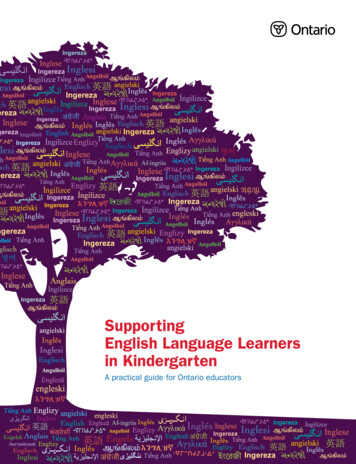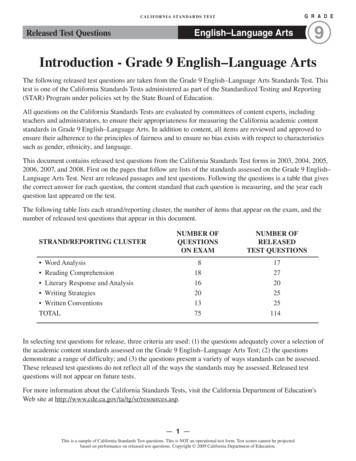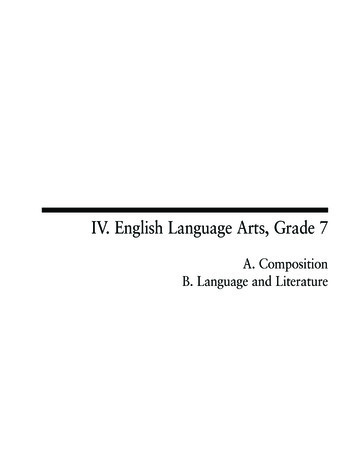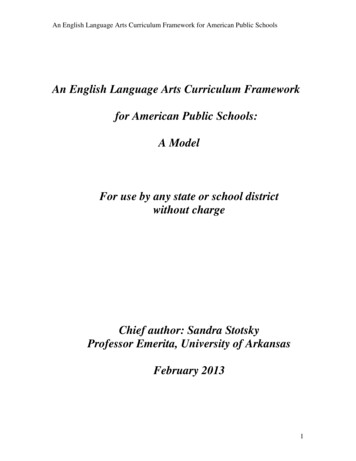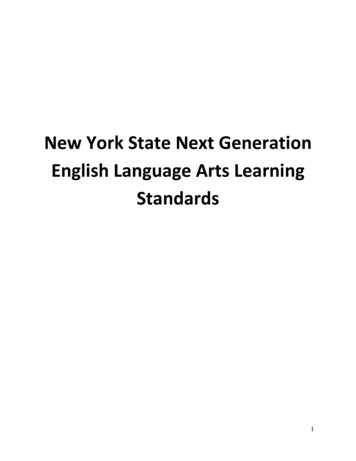
Transcription
IV. English Language Arts,Reading Comprehension, Grade 5
Grade 5 English Language ArtsReading Comprehension TestThe spring 2015 grade 5 English Language Arts Reading Comprehension test was based on Pre-K–5learning standards in two content strands of the Massachusetts Curriculum Framework for EnglishLanguage Arts and Literacy (March 2011) listed below. Page numbers for the learning standards appearin parentheses. Reading (Framework, pages 13–19) Language (Framework, pages 33–40)The Massachusetts Curriculum Framework for English Language Arts and Literacy is available on theDepartment website at www.doe.mass.edu/frameworks/current.html.ELA Reading Comprehension test results are reported under two MCAS reporting categories, Readingand Language, which are identical to the two framework content strands listed above.The tables at the conclusion of this chapter indicate each released and unreleased common item’s reportingcategory and the standard it assesses. The correct answers for released multiple-choice questions are alsodisplayed in the released item table.Test Sessions and Content OverviewThe grade 5 ELA Reading Comprehension test included two separate test sessions. Each session includedreading passages, followed by multiple-choice and open-response questions. Selected common readingpassages and approximately half of the common test items are shown on the following pages as theyappeared in test booklets.Reference MaterialsDuring both ELA Reading Comprehension test sessions, the use of bilingual word-to-word dictionaries wasallowed for current and former English language learner students only. No other reference materials wereallowed during any ELA Reading Comprehension test session.43
Grade 5 English Language ArtsReading ComprehensionDIRECTIONSThis session contains two reading selections with fifteen multiple-choice questions and two openresponse questions. Mark your answers to these questions in the spaces provided in your StudentAnswer Booklet.Young drummer boys played an important role in the Civil War for both the Union (Northern) andConfederate (Southern) armies. Read the passage and answer the questions that follow.Drumbeats and Bulletsfrom The Boys’ Warby Jim MurphyTwoke up to a persistent, brain-rattling drummingnoise. Thrump. Thrump. Thrump. He rolled over in an attempt toignore the sound and pulled his blanket up over his head. The drummingwent on and intensified as drummers all over camp signaled the call tomuster.1 There was no escaping it, and eventually — and usually with agrumble — the soldier got up to start another day.2 Soldiers probably came to hate the sound of the drums, especiallywhen they heard them on a drizzly, cold morning. Yet drummer boys whoserved during the Civil War provided valuable service to the armies ofboth sides, although some didn’t realize it at first.3“I wanted to fight the Rebs,”2 a twelve-year-old boy wrote, “but Iwas very small and they would not give me a musket. The next day Iwent back and the man behind the desk said I looked as if I could holda drum and if I wanted I could join that way. I did, but I was not happyto change a musketfor a stick.”4 This boy wasdisappointed atbeing assigned a“nonfighting” and,to him, dull job.Most likely, hesaw himself alwaysdrumming inparades or in thesafety of camp. Hewould soon learnThe drum corps of the Ninety-third New York Infantry.differently.112he groggy soldiermuster — to assemble troopsRebs — a nickname given to soldiers in the Confederate army44
ELA Reading Comprehension 56789The beat of the drum was one of the most important means ofcommunicating orders to soldiers in the Civil War. Drummers did findthemselves in camp sounding the routine calls to muster or meals andproviding the beat for marching drills. But more often than not, they werewith the troops in the field, not just marching to the site of the battle butin the middle of the fighting. It was the drumbeat that told the soldiershow and when to maneuver as smoke poured over the battlefield. Andthe sight of a drummer boy showed soldiers where their unit was located,helping to keep them close together.Drummers were such a vital part of battle communication that theyoften found themselves the target of enemy fire. “A ball3 hit my drumand bounced off and I fell over,” a Confederate drummer at the Battleof Cedar Creek recalled. “When I got up, another ball tore a hole in thedrum and another came so close to my ear that I heard it sing.”Naturally, such killing fire alarmed many drummer boys at first. Butlike their counterparts with rifles, they soon learned how to face enemyshells without flinching.4 Fourteen-year-old OrionHowe was struck by several Confederate bulletsduring the Battle of Vicksburg in 1863. Despite hiswounds, he maintained his position and relayed theorders given him. For his bravery, Howe would laterreceive the Medal of Honor.Drumming wasn’t the only thing these boys did,either. While in camp, they would carry water, rubdown horses, gather wood, or cook for the soldiers.There is even evidence that one was a barber forthe troops when he wasn’t drumming. After a battle,most drummers helped carry wounded soldiers offthe field or assisted in burial details. And manydrummer boys even got their wish to fight theenemy.Fighting in the Civil War was particularlybloody. Of the 900 men in the First Maine HeavyArtillery, 635 became casualties in just sevenminutes of fighting at the Battle of Petersburg. ANorth Carolina regiment saw 714 of its 800 soldierskilled at Gettysburg. At such a time, these boys putdown their drums and took up whatever rifle wasJohnny Clem, twelve,handy. One such drummer was Johnny Clem.just after the Battleof Shiloh, 1862.34ball — a lead ball fired from a gunflinching — drawing away; falling back45
ELA Reading Comprehension 10Clem ran away from home in 1861 when he was eleven years old.He enlisted, and the Twenty-second Michigan Regiment took him in astheir drummer, paying him thirteen dollars a month for his services.Several months later, at the Battle of Shiloh, Clem earned the nicknameof “Johnny Shiloh” when a piece of cannon shell bounced off a tree stumpand destroyed his drum. When another drum was shattered in battle, Clemfound a musket and fought bravely for the rest of the war, becoming asergeant in the fall of 1863.11The Civil War would be the last time drummer boys would be used inbattle. The roar of big cannons and mortars, the rapid firing of thousandsof rifles, and the shouts of tens of thousands of men made hearing adrumbeat difficult. More and more, bugles were being used to pass alongorders. Military tactics were changing, too. Improved weapons made itimpractical to have precise lines of soldiers face their enemy at closerange. Instead, smaller, fast-moving units and trench warfare, neither ofwhich required drummers, became popular.12Even as their role in the fighting was changing, Civil War drummersstayed at their positions signaling orders to the troops. Hundreds werekilled and thousands more wounded. “A cannon ball came bouncing acrossthe corn field,” a drummer boy recalled, “kicking up dirt and dust eachtime it struck the earth. Many of the men in our company took shelterbehind a stone wall, but I stood where I was and never stopped drumming.An officer came by on horseback and chastised the men, saying ‘this boyputs you all to shame. Get up and move forward.’ We all began movingacross the corn field. . . . Even when the fighting was at its fiercest andI was frightened, I stood straight and did as I was ordered. . . . I felt Ihad to be a good example for the others.”“Drumbeats and Bullets” by Jim Murphy, from The Boys’ War. Text copyright 1990 by Jim Murphy. Reprinted by permission of ClarionBooks, an imprint of Houghton Mifflin Harcourt Publishing Company. Photograph of the Union Drum Corps copyright CORBIS.Photograph of Johnny Clem in the public domain.46
ELA Reading Comprehension ID:291605 A Common1 ID:291604 C Common4 Read the sentence from paragraph 3 inthe box below.Based on the passage, what was true ofthe drummer boys?A. They were protected from gunfire.“. . . I was not happy to change amusket for a stick.”B. They were required to join the army.C. They were younger than mostsoldiers.What does the sentence mostly suggestabout the drummer boy?D. They were there to entertain thetroops.A. He wanted to be a fighting soldier.B. He already knew how to play a drum.C. He was more patriotic than other boys.ID:291613 B CommonD. He sometimes was asked to carry a gun.5 The drumming went on and intensifiedas drummers all over camp signaledthe call to muster.ID:291606 A Common2 Read the sentence from paragraph 1 inthe box below.According to the passage, what wasthe most important job of thedrummer boys?Based on the sentence, what does theword intensified mean?A. passing on orders during battleB. helping to care for the woundedA. changed beatC. keeping the camps running properlyB. grew strongerD. scouting the position of enemy spiesC. ended suddenlyD. became musicalID:291607 B Common3 Which detail from the passage illustrateshow valuable the drummer boys were?A. Military tactics changed duringthe Civil War.B. Orion Howe was awarded theMedal of Honor.C. A North Carolina regiment lostmany soldiers at Gettysburg.D. Johnny Clem joined the Twentysecond Michigan Regiment.47
ELA Reading Comprehension Question 6 is an open-response question. ead the question carefully.R Explain your answer. Add supporting details. Double-check your work.Write your answer to question 6 in the space provided in your Student Answer Booklet.ID:291620 Common6 Based on the passage, explain how drummer boys showed bravery in doing their jobs. Supportyour answer with important details from the passage.48
ELA Reading Comprehension In the book Turtle in Paradise, Turtle is a young girl who is living with her aunt’s family for a while in KeyWest, Florida, in the 1930s. In this selection, Turtle first gets to know her Nana Philly (who is ill) by goingto help her at lunchtime. Read the selection and answer the questions that follow.fromTurtle in Paradiseby Jennifer L. HolmWe’re walking out the front door to go to the matinee1 when Aunt Minnie calls to usfrom where she’s ironing in the parlor.2“I’m sorry,” she says, wiping a hand on her forehead. “But one of you kids is goingto have to go over to Nana Philly’s and give her lunch. I’ve just got too much laundry todo today.”3“Not me,” Beans says quickly.4“Me neither!” says Kermit.5“No way, no how, Ma!” Buddy says.6 Aunt Minnie looks up at the ceiling as if she’s praying for patience. She’s going tobe praying a long time at this rate.7“I’ll do it,” I say. Nana Philly can’t be any worse than Shirley Temple.28Aunt Minnie gives me a long look. “Thank you, Turtle,” she says. She sounds surprised.“You’re a good girl.”9“Course I am,” I say. “You’re just used to rotten boys.”1“Why, Turtle!” Miss Bea says with a confused smile when she opens the door. “Howlovely to see you! But I was expecting your aunt.”11“Aunt Minnie’s got laundry. I’ll give Nana Philly her lunch,” I say.12 “Aren’t you a dear,” she says. “Well, whatever you make her, just be sure it’s soft.”She lowers her voice a notch. “Her teeth aren’t very good.”13“All right,” I say.14 “I won’t be long,” she says, walking down the steps. “You’re so sweet todo this!”15But I’m not sweet—I’m curious. It’s not every day you find out you have a grandmotheryou didn’t even know was alive. And despite what everyone says about Nana Philly beingterrible, I’ve been wanting to see if she’ll be different with me. After all, I’m a girl. Maybeshe just hates boys. Wouldn’t blame her if she did.16 I walk into the house with fresh eyes. This is where Mama grew up. A thousandquestions flash through my mind: Which bedroom did she sleep in? Did she run up anddown the hallway? Did she sit at the piano? I hope not. That stool doesn’t look too sturdy.17Nana Philly is sitting in the rocking chair in her bedroom reading a new magazine.She’s dressed the same way as when I first saw her.1012matinee — an afternoon movieShirley Temple — a child movie star of the time49
ELA Reading Comprehension 18“I don’t know if you remember me, but I’m Turtle,” I say. “Your granddaughter.”She looks up.20“Sadiebelle’s girl.”21And blinks.22“Mama’s in New Jersey,” I explain. “She got a job as a housekeeper to a rich lady.”23Nana Philly stares at me.24“I’m supposed to make you lunch. You hungry?” I ask.25The old lady doesn’t say anything; she just looks back down at her magazine. It’s notexactly the tearful reunion I was imagining, although maybe that blink was her way ofsaying she was happy to see me. Then again, maybe she has dust in her eye.26I go into the kitchen and look around. Mama’s always making fancy lunches for theladies she works for. You wouldn’t even know people were standing in breadlines3 if youwalked in and saw what they were eating: iced cantaloupe, shrimp aspic, caviar sandwicheswith cream cheese, hearts of lettuce with French dressing, meringue cookies.27There’s no caviar or cream cheese in sight, but there is bread on the table and milkin the icebox,4 so I decide to make milk toast. I toast up some bread, stick it in a bowl,and pour milk over it. It’s tasty, and it’s mushy.28 Nana Philly eyes the bowl suspiciously when I place it on the little table in frontof her.29“It’s milk toast,” I say. “We eat it all the time.” Strange as it seems, I want her to like it.30She doesn’t move and then I realize why.31“Oh, no! I forgot your spoon,” I say, and rush back into the kitchen. I hear a thump,and when I return, the bowl is lying facedown on the floor, milk splattered everywhere.32“What happened?” I ask.33Nana Philly doesn’t say anything. Not that I really expect her to.34“I must have put it too close to the edge,” I say, and clean up the mess. Then I setabout making another bowl of milk toast. I bring it out—with a spoon this time—andplace it in front of her on the little table.35“Here you go,” I say. “I hope you like it.”36She looks at the bowl for a moment and then her hand whips out and knocks it rightoff the table and onto the floor.37I’m so shocked, I just stand there. I didn’t really believe what the boys said about herbefore, but I do now.38“You did that on purpose,” I say. “Why? I’m your granddaughter!”39Her mouth twitches as if this amuses her.40 Something hopeful in me hardens. She reminds me of all the rotten kids I’ve everlived with.1934breadlines — lines of people waiting to receive free food given by the government in the 1930sicebox — refrigerator50
ELA Reading Comprehension 41“You don’t scare me,” I say.I clean up the mess again and make another bowl of milk toast. But this time I don’tgive it to the mean old lady who’s my grandmother; instead, I sit down in a chair andstart eating. She stares at me, her eyes following every spoonful.43“This is delicious,” I say, and smile. “Shame you spilled yours.”44I swear I can see her mouth watering.42When Miss Bea returns, Nana Philly and I are sitting in the parlor.“Did you two have a nice lunch?”47“We had a lovely time,” I say.48 “Would you like to come again tomorrow? Give your poor aunt a break?”Miss Bea asks.49 “Sure,” I say, and smile sweetly at Nana Philly. “I’m looking forward to getting toknow my grandmother.”4546Miss Bea’s waiting for me on the front porch with her shopping basket when I arrive thenext afternoon.51 “There’s grits-and-grunts-and-gravy on the stove and guava duff for dessert. There’splenty for both of you,” Miss Bea says. “I’ve got shopping to do, so I might be a while.”52“Take your time,” I say.53“Thank you, Turtle,” she says. “You’re a dear.”54Nana Philly’s in her room looking at her magazine as usual. I notice it’s upside down.55“Must be some real interesting reading you got there,” I say.56The old woman ignores me, so I go into the kitchen. I spoon out two bowls of gritsand-grunts-and-gravy. Folks here eat this all the time. Grunts are little fish and grits arelike porridge. That’s the one good thing about Key West: there’s food everywhere—hangingfrom trees, in the ocean—and it’s all free.57After what happened yesterday at lunch, I figured Nana Philly would have wised up.But I guess you can’t teach a mean old lady new tricks, because the bowl hasn’t beenin front of her for more than a moment when her hand knocks it off the table. It falls tothe floor in a splatter.58“You know, there sure are a lot of hungry folks who would have liked to eat that,” Isay, but all she does is stare at the upside-down magazine a little harder.59 I clean up the mess and eat my own lunch with her watching the whole time. It’suncomfortable, but it’s just like dealing with a rotten kid: if you back down in front ofthem, they’ll never leave you be.60When I’m finished, I carry a bowl of guava duff out and place it in front of her. Shelifts her hand to smack it, but I snatch it away just in time.61“You’re not wasting dessert,” I say. “I’ll eat it.”62I sit down and take a bite. It’s delicious. It tastes a little like plum pudding.63“Miss Bea sure is a good cook.”64Nana Philly pretends to ignore me, but I can tell she’s watching. She reminds me ofa lobster, with her beady eyes peeking out at me from under her red hat.5051
ELA Reading Comprehension 65“Mama’s a good cook, too. She makes the best caramel custard. One of our old employers,Mr. Hearn, couldn’t get enough of it. He had her make it four nights a week.”66I study Nana Philly closely. “You know, Mama told me you were dead.”67She glances down quickly, and it comes to me.68“You were mean to her, too, weren’t you?” I ask. “Is that why she hasn’t come backto Key West?”69My grandmother doesn’t look up, and I know the answer to my own question.70 “Poor Mama,” I whisper. Chased off by her own mother. No wonder she’s sucha wreck.71 A shadow crosses Nana Philly’s face and, for a brief moment, I see something likeregret in her blue eyes, but then it’s gone.***It happens just like in the Bible: on the third day, there’s a miracle.“I can tell the old girl’s really looking forward to seeing you today,” Miss Bea says.74I doubt that, but say, “Really?”75“Even had me get out her best hat,” Miss Bea says.76I’m not impressed. I didn’t even want to come here today after what I learned yesterday,but Aunt Minnie got used to me helping out, so I don’t have any choice now. This is whatI get for being a good girl.77When I walk into the bedroom, Nana Philly puts down her magazine and looks at me.She’s wearing a royal blue hat with a peacock feather.78“You expecting the queen?” I ask.79Miss Bea has made conch chowder, and it’s simmering on the stove. I fill two bowlsand carry them out, placing one in front of Nana Philly. I sit down with my bowl andstart eating, waiting to hear her bowl hit the floor. But when I look up, she’s holding thespoon. She brings it to her mouth with her good hand and swallows the chowder.80She takes another spoonful. And another.81Soon her bowl is empty.82“You know,” I say, “I missed seeing a matinee the first day when I came here to giveyou lunch. It was a Shirley Temple picture.”83Her eyes fly to my face.84“Which is fine by me, because I hate Shirley Temple,” I say.85 A corner of my grandmother’s mouth turns up in a crooked smile, and hereyes shine.86“Me thoo,” she says.7273Turtle in Paradise by Jennifer L. Holm. Copyright 2010 by Jennifer Holm. Reprinted by permission of Random House Children’s Books,a division of Random House LLC.52
ELA Reading Comprehension ID:298382 A Common7 ID:298388 A Common9 Based on paragraphs 1–6, why is AuntMinnie “praying for patience”?In paragraph 16, what do the questionsrepresent?A. because her children refuse to helpA. Turtle’s thoughtsB. because she has not yet prepared lunchB. Turtle’s confusionC. because her children are not supposedto go outC. Turtle’s memoriesD. Turtle’s conversationD. because she is having a hard time withthe ironingID:298390 B Common10 ID:298397 C Common8 Based on the selection, what does Turtlemost likely hope to gain from her visits toNana Philly?Read Turtle’s comments from paragraph 25in the box below.It’s not exactly the tearful reunion I wasimagining, although maybe that blinkwas her way of saying she was happy tosee me. Then again, maybe she has dustin her eye.A. Turtle wants to find out why NanaPhilly has been ill.B. Turtle wants to show Nana Philly thatshe is dependable.What do the comments suggest aboutTurtle?C. Turtle wants to know more about hermother and Nana Philly.A. She is unhappy that she offered tohelp Nana Philly.D. Turtle wants to convince her aunt andcousins to like Nana Philly.B. She is uncertain how Nana Phillyfeels about her.C. She is concerned that Nana Phillymay be hurt.D. She is growing impatient withNana Philly.53
ELA Reading Comprehension ID:298394 B Common11 ID:298398 D Common13 In the selection, the spaces betweenparagraphs 9 and 10, 44 and 45, and 49and 50 all show a change inWhat does the description of Nana Phillyin paragraph 71 suggest?A. She is becoming weaker and moreforgetful.A. plot.B. time.B. She is trying to make others feel sorryfor her.C. theme.C. She is upset because she has missedher dessert.D. narrator.D. She is starting to feel bad about whatshe has done.ID:298393 A Common12 In the selection, how does Turtle teachNana Philly a lesson?ID:298401 B CommonA. by eating in front of Nana Philly14 B. by refusing to help Nana Philly againWhat does the end of the selectionsuggest?C. by telling her aunt how Nana PhillybehavedA. Turtle and Nana Philly will go tothe movies.D. by convincing her cousins to visitNana PhillyB. Turtle and Nana Philly will start toget along.C. Turtle believes Nana Philly is gettingstronger.D. Turtle believes Nana Philly is goingto knock over her lunch.54
ELA Reading Comprehension ID:298402 B Common15 ID:298404 A Common16 In the selection, which of the following isa problem Turtle faces?In paragraph 26, how are commas used?A. to separate items in a listA. She gets in trouble for the mess NanaPhilly makes.B. to show a series of eventsC. to show a ranking byimportanceB. She does not understand why NanaPhilly acts mean.D. to separate words fromtheir definitionsC. She does not feel appreciated forhelping Nana Philly.D. She has to take care of Nana Phillywhile her cousins play.55
ELA Reading Comprehension Question 17 is an open-response question. ead the question carefully.R Explain your answer. Add supporting details. Double-check your work.Write your answer to question 17 in the space provided in your Student Answer Booklet.ID:298406 Common17 Based on the selection, describe Turtle’s character traits. Support your answer with importantdetails from the selection.56
Grade 5 English Language ArtsReading ComprehensionSpring 2015 Released Items:Reporting Categories, Standards, and Correct Answers*StandardCorrect anguage2A1756Reading3Item No.Page No.1472Reporting Category* Answers are provided here for multiple-choice items only. Sample responses and scoring guidelines for the open-response items,which are indicated by the shaded cells, will be posted to the Department’s website later this year.57
Grade 5 English Language ArtsReading ComprehensionSpring 2015 Unreleased Common Items:Reporting Categories and StandardsItem No.Reporting 458
Reading Comprehension Test The spring 2015 grade 5 English Language Arts Reading Comprehension test was based on Pre-K–5 learning standards in two content strands of the Massachusetts Curriculum Framework for English Language Arts and Literacy (March 2011) listed below. Page

